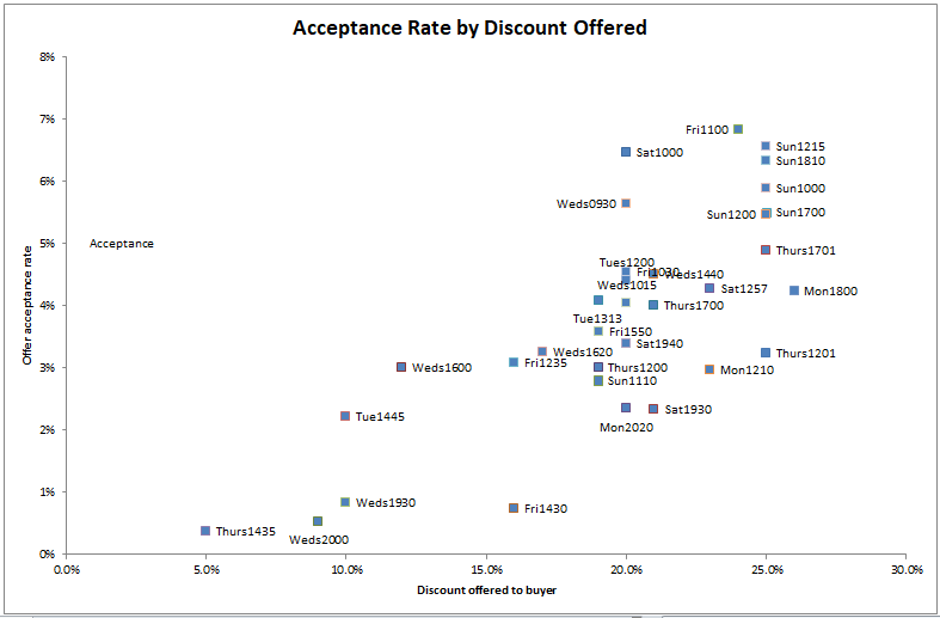 David Brackin, managing director of Stuff U Sell, the leading eBay trading assistant in the UK and a regular Tamebay contributor, takes a deep dive into eBay Offer to Buyer and today presents his quantitative research analysis into the effectiveness of the new tool:
David Brackin, managing director of Stuff U Sell, the leading eBay trading assistant in the UK and a regular Tamebay contributor, takes a deep dive into eBay Offer to Buyer and today presents his quantitative research analysis into the effectiveness of the new tool:
Does eBay’s “Offer To Buyer” promotion tool work?
The Offer To Buyer feature represents a new and effective eBay tool for sellers to increase sales. Using emotional cues to tip purchase intent into completed sale, and with take-up rates of up to 6%, driven primarily by discount depth and secondarily by timing, it offers a rapid and effective way to drive sales. While the product is new and needs considerable improvements from eBay, sellers should already be actively experimenting to measure the effect on their inventory.
Background
In Spring last year, eBay started rolling out a new feature allowing sellers actively to send an offer to buyers. Known as “Offer to Buyer”, it is an enhancement of the long-established Best Offer feature which we put to the test last year. Accessed through the live listings tab of seller hub, the seller sets a price or discount percentage on an item or group of items and the offer is sent privately to the buyers who have put the item in their watchlist. This has been recently enhanced also to include buyers who shown an interest by viewing the item multiple times.
Having produced the definitive quantitative research last year to independently examine how eBay’s claims about the effectiveness of Promoted Listings stacked up, we decided to run similar trials on Offer To Buyer to see how it worked. In particular to answer the question of how the discount offered affects the take-up rate, and whether there is an optimal time to send out offers.
Offers really appeal to online shoppers
In a recent presentation, Rob Hattrell, VP of eBay UK shed some light on the emotional side of consumer purchases. We often think about price, selection, trust and convenience – the cornerstones of rational purchase decisions – but this ignores the emotional drivers of purchases. Buyers want the elation of “finding a prize”; they want to “beat the system” and also feel that it is simple and that they are in control, explained Hattrell. This is backed-up by statistics: 70% of buyers are motivated to purchase by discount codes. The idea driving Offer to Buyer is that it uses this emotional tug of having got a special deal that no one else had access to and so “beating the system” to get a great price.
Furthermore, with last year’s GTC mandate where shorter duration fixed price listings were banished, eBay had carelessly discarded one of the important triggers to convert interested shoppers into buyers – the fear of missing out as a listing approached its end. Offer To Buyer goes some way to replacing this.
What we really like about the feature is that it properly exploits the eBay ecosystem. So many eBay promotions look just like store discounts pandering to the brand-sellers – buy one get one free – the sort of thing you see in a failing high street store. This feels like it properly exploits the power of the marketplace.
Making offers and tracking results
The interface for making offers is based on some pretty slow and creaky browser tech and tracking results is virtually impossible. Within the active listings tab of Seller Hub there’s a button to select listings which are eligible to send an offer, and then you can choose up to 200 listings at a time to set a discount and customised message. The product feels very much in beta where you have to work to get the offers out there and frequent bugs and resets. There’s no option to automate, use APIs or third-party tools – it’s all by hand on the webpage and it’s really slow: when I timed it, it took me 30-40 minutes to send 1,400 offers. Furthermore it’s pretty much impossible to track the results of your offers – we produced the trial results by running queries on Linnworks data to identify where discounts had been accepted.
Trial results – discounts drive sales
Over two months we ran a variety of trials – offering different levels of discounts from 5% to 25% at different times of the day and week.

The graph shows that offer to buyer has a significant effect in conversion. For the higher discounts around 6% of the items sold. Furthermore nearly half of these sales were within one hour of the offer being made: Offer to Buyer is not only effective but is also really fast.
You are limited to making offers once per month per buyer per listing so it’s worth noting that the best results we saw were Fri / Sat / Sun sending offers out around midday. Mon-Weds were weaker.
So is this a good idea for your store? These results were fairly consistent on our inventory – we sell across a wide range of categories with mostly single items, often second-hand – and the depth of discount you can offer will depend on the margin you have available – that will vary store by store, but we saw results once we got over 10%, and some impressive impact at 25%. Whether it works for your store is something which only experimentation can tell, but our initial findings are that while it can be hard work, Offer to Buyer is worth the effort looking into and is a powerful eBay-native tool for converting sales. Given this, hopefully eBay will put the effort into improving both the execution and reporting around the product.
Have you tried using offer to buyer? Have you seen similar results? I’d be interested to hear from other sellers and their experiences.










15 Responses
It’s hit and miss but it does work.
Also don’t forget it helps push the item in main search as they are still sales. For example we sent an offer on an item, sold two in an hour, then sold one at full price straight away.
It definitely needs some work but I think it’s worth trying here and there.
I’ve tried it with 10% on several items, several times, with very little take up. Off the top of my head, it’s probably about 2% take up at best.
It seems to me in the antique category the “make offer “ only seems to work on occasion if it’s a 50% discount. Take up rate in my opinion is still little better than 3% even then. It’s a waste of time and makes sellers look desperate.
These studies are great!
Would love to see periodic updates or re-runs (as eBay continues to ‘tweak’ things), particularly with Promoted Listings.
I’ve been doing a 15% discount, and getting very few takers. I’ll try doing it on the weekends to see if that might help.
Yeah those make sense if one sells second hand high-endish products. I cannot “see” those offers as successful in our category (veh parts) where the margin % is very tight already. To the point it’s not worth listing some of items at all.
Wouldn’t work for us…. margins are so very tight that we would have to put up prices to make it work. In fact just about every ebay way of increasing sales seems to require us to push up the original price!
I’m sure it will work well for those where there isn’t hundreds of similar listings all on a race to the bottom on price…
Still… it is effectively a free tool for sellers, so can’t complain too much.
For those suggesting that they don’t have margin:-
— do you run any other promotions (free shipping / order / basket discounts / promoted listings?) and how do you compare margin loss in one vs the other?
— do you ever have “dead” stock — end of line or returns/defect stock that needs clearing for cash recovery rather than core margin? Would that give flexibility to try promotions.
The can be some drawbacks to “offer to buyer”, that need to be considered.
1. The distinctive alert sound, when using the ebay app, can be annoying and some buyers may not wish to receive unsolicited offers at certain times of the day or night. Worth bearing in mind if you have watchers in different time zones.
2. If you send an offer that is accepted, your overall sales figures displayed both on the website and the app will still reflect the original asking price. In other words, if you have an item listed at £100, and send an offer that is accepted, your sale will still show up as making £100, and so your aggregated tally will show an incorrect figure. A bit of a glitch perhaps, so you need to ensure you’re aware of this if you’re basing any kind of accounts calculation on your displayed sales figures.
3. Sellers who use “make an offer” will gradually be perceived, at least by regular customers, and ultimately by all ebay customers across the globe, as indicative that sellers are building extra margin into their pricing so as to allow for making an offer at some point, and this may hit regular fixed price sales over time. If this process of perception continues then we’ll all be locked in to a tedious arrangement whereby we list for a while, and then make an offer, which might well increase the time it takes to sell. And as we all know, longer listing times only benefit ebay. From my experience, there’s certainly a growing number of customers who will demand some sort of deal, even if I haven’t added a “make offer” to a listing, and I do wonder whether this trend is being fuelled by sellers using “offer to buyer”. If we’re increasingly going to see ebay heading into bartering territory then we’d better be prepared to allow more time to deal with these pre-sale negotiations, negotiations that can just as easily lose a sale as to gain a sale.
4. And finally, we should all remember that our items are “watched” by competitors too, and so sending an “offer to buyer” to all the watchers means your competitors will also be seeing your offers strategy.
Personally, I don’t use the scattergun approach of “make offer to buyer” for the reasons set out above, but I do use “reply with offer” to good effect when a potential customer asks a question.
we use the ultimate make an offer option in reverse for dead stock
its called an AUCTION